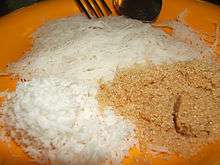Putu mayam
 Putu Mayam. | |
| Alternative names | Idiyappam, putu piring and putu mayang |
|---|---|
| Place of origin | India |
| Region or state | Southern India, Sri Lanka, Malaysia, Indonesia and Singapore |
| Main ingredients | Flour, water and coconut milk |
|
| |
Putu mayam in Malay or Idiyappam (இடியாப்பம்) in Tamil is a Tamil dish from southern India. It is popular in southern India, Sri Lanka, Malaysia, Indonesia, and Singapore.
The process for making putu mayam (also known as string hoppers in English) consists of mixing rice flour or idiyappam flour with water and/or coconut milk, and pressing the dough through a sieve to make vermicelli-like noodles. These are steamed, usually with the addition of juice from the aromatic pandan leaf (screwpine) as flavouring. The noodles are served with grated coconut and jaggery, or, preferably, gur (date palm sugar). In some areas, gula melaka (coconut palm sugar) is the favourite sweetener.
In Malaysia and Singapore, putu mayam and its relatives are commonly sold as street food from market stalls or carts, as well as being made at home, and are usually served cold. In Indonesia, putu mayam is called Putu mayang and is served with palm sugar mixed with coconut milk.
Putu piring is a Malaysian version of putu mayam in which the rice flour dough is used to form a small cake around a filling of coconut and gur or jaggery.[1]
The origins of these dishes may stem from Tamil Nadu, southern India, where a similar rice flour noodle is served with sugar and coconut, and sometimes banana too, and is known as idiyappam. This dish may be eaten for breakfast with a vegetable stew or aviyal, or a fish curry, etc. The same liking for serving the slightly sweet putu mayam, putu piring, or cendol with savoury dishes also occurs in Malaysia and Singapore. Idiyappam is typical of Kerala, Tamil Nadu, and other southern Indian states, as well as Sri Lanka. A very finely ground, commercial iddiyapam flour is sold as a sort of "instant" way to make all of these dishes.
See also
- Idiyappam
- Kueh tutu
- Cuisine of Singapore
- Malaysian cuisine
- Indian cuisine
- Indonesian cuisine
- List of steamed foods